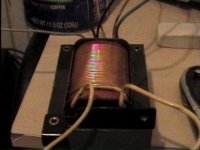ballast?
That looks and sounds more like an ordinary transformer:
20/125/240/250v probably is missing a leading "1", which means it has a common lead and four input power leads. You pick the lead that matches your AC power line voltage.
24v-150w means it puts out 24 volts AC RMS, at up to 150 Watts. So the maximum current output would be 150/24 = 6.25 amps. That is a pretty hefty transformer! You can use it to run 24 volt lamps or AC fans, up to 150 Watts, which is probably just what it was doing in the projector. You can also use it to run a pair of 12 volt lights wired in series, as long as they have exactly the same current rating.
Or you could connect the 240 volt input lead to a 120 volt power line, to get 12 volts out. Theoretically, that would give you 12.5 amps, but the wire guage is probably not big enough for that.
This is probably not very useful for a DIY projector (just too big!), but a DIY electronics experimenter could use it to build a great adjustable power supply.
It is only worth about $20, so the shipping weight probably makes it unsellable on eBay, but you could try. List it as "12 volt transformer, 120/125/240/250 volts in, 12 volts 6.25 amps out". If it doesn't sell, find a local high school with an electronics class to donate it, if you don't have any electronics geek buddies.
That looks and sounds more like an ordinary transformer:
20/125/240/250v probably is missing a leading "1", which means it has a common lead and four input power leads. You pick the lead that matches your AC power line voltage.
24v-150w means it puts out 24 volts AC RMS, at up to 150 Watts. So the maximum current output would be 150/24 = 6.25 amps. That is a pretty hefty transformer! You can use it to run 24 volt lamps or AC fans, up to 150 Watts, which is probably just what it was doing in the projector. You can also use it to run a pair of 12 volt lights wired in series, as long as they have exactly the same current rating.
Or you could connect the 240 volt input lead to a 120 volt power line, to get 12 volts out. Theoretically, that would give you 12.5 amps, but the wire guage is probably not big enough for that.
This is probably not very useful for a DIY projector (just too big!), but a DIY electronics experimenter could use it to build a great adjustable power supply.
It is only worth about $20, so the shipping weight probably makes it unsellable on eBay, but you could try. List it as "12 volt transformer, 120/125/240/250 volts in, 12 volts 6.25 amps out". If it doesn't sell, find a local high school with an electronics class to donate it, if you don't have any electronics geek buddies.
thanks for the reply.
the only reson i thought it was a ballast it because the two big yellow wires on the other side were connected to the lamp.
the only reson i thought it was a ballast it because the two big yellow wires on the other side were connected to the lamp.
wires connected to the lamp
And I bet the lamp has a filament.
A ballast is more complex so it can start an arc lamp, and then keep delivering a constant current as the arc's resistance goes down. A bulb with a filament is either just a plain old tungsten incandescent or a tungsten incandescent with a halogen gas to make it last longer running with more current. These just get a particular constant voltage, so they don't need a ballast.
The lamp that goes with that transformer would run from a 24 volt RMS AC source, or from 24 volts DC. The yellow wires are big so they can handle the 6.5 amps of current without melting.
And I bet the lamp has a filament.
A ballast is more complex so it can start an arc lamp, and then keep delivering a constant current as the arc's resistance goes down. A bulb with a filament is either just a plain old tungsten incandescent or a tungsten incandescent with a halogen gas to make it last longer running with more current. These just get a particular constant voltage, so they don't need a ballast.
The lamp that goes with that transformer would run from a 24 volt RMS AC source, or from 24 volts DC. The yellow wires are big so they can handle the 6.5 amps of current without melting.
- Status
- Not open for further replies.

